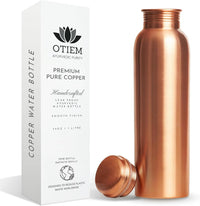Copper Benefits | In the Press
Copper is Amazing.
Copper is so amazing that researching the effect natural copper has on water is one of the reasons that lead us to the creation of the Otiem Copper Water Bottle in the first place.
The bottle is based on the fact that when you keep water inside a copper vessel for extended periods of time, the water begins to absorb a very small amount of copper, this naturally ionizes the water, and it even starts to become more alkaline and starts to kill bacteria! Best of all, this all happens completely naturally and is 100% safe!
However that's not all copper does! In fact when we first tried to explain all the things that copper could do, people didn't even believe us! So instead, we're asking you not to take our word for it, and take theirs instead:
Below are excerpts from various media outlets breaking down the science behind copper's effect on water!
You'll quickly see why we wanted you to be able to take advantage of this amazing element, no matter where you are, with a portable water bottle version!
Shayla Love, VICE
"Copper is antimicrobial. It kills bacteria and viruses, sometimes within minutes. Since then, studies have shown that copper is able to destroy the microbes that most threaten our lives. It has been shown to kill a long list of microbes, including norovirus, MRSA, a staph bacteria that has become resistant to antibiotics, virulent strains of E. coli that cause food-borne illness.
If copper were more frequently used in hospitals, where 1 in 31 people get healthcare-acquired infections (HAI), or in high-traffic areas, where many people touch surfaces teeming with microbial life—it could play an invaluable role in public health, said Michael Schmidt, a professor of microbiology and immunology at the Medical University of South Carolina, who studies copper. And yet, it is woefully absent from our public spaces, healthcare settings, and homes.
“What happened is our own arrogance and our love of plastic and other materials took over,” Schmidt said of the cheaper products more frequently used. “We moved away from copper beds, copper railings, and copper door knobs to stainless steel, plastic, and aluminum.”
On copper surfaces, bacteria and viruses die. When a microbe lands on a copper surface, the copper releases ions, which are electrically charged particles. Those copper ions blast through the outer membranes and destroy the whole cell, including the DNA or RNA inside. Because their DNA and RNA are destroyed, it also means a bacteria or virus can’t mutate and become resistant to the copper, or pass on genes (like for antibiotic resistance) to other microbes.
Before people even knew what bacteria and viruses were, they knew that copper could—somehow—ward off infection. The first recorded medical use of copper is from one of the oldest-known books, the Smith Papyrus, written between 2600 and 2200 B.C.
Schmidt said that using copper along with standard hygiene protocols hasbeen shown to reduce bacteria in health care settings by 90 percent.
Copper is antimicrobial regardless of how grody it looks, if it turns green on you, it still has the ability to kill bacteria and viruses and fungi,” he said."
Read the full article HERE
Mark Wilson, Fast Company
"In China, it was called “qi,” the symbol for health. In Egypt it was called “ankh,” the symbol for eternal life. For the Phoenicians, the reference was synonymous with Aphrodite—the goddess of love and beauty.
These ancient civilizations were referring to copper, a material that cultures across the globe have recognized as vital to our health for more than 5,o00 years.
When influenzas, bacteria like E. coli, land on most hard surfaces, they can live for up to four to five days. But when they land on copper, and copper alloys like brass, they begin to die within minutes and are undetectable within hours. “We’ve seen viruses just blow apart,” says Bill Keevil, professor of environmental healthcare at the University of Southampton. “They land on copper and it just degrades them.”
No wonder that in India, people have been drinking out of copper cups for millennia. Even here in the United States, a copper line brings in your drinking water. Copper is a natural, passive, antimicrobial material. It can self-sterilize its surface without the need for electricity or bleach.
In Keevil’s work, he dips a plate of copper into alcohol to sterilize it. Then he dips it into acetone to get rid of any extraneous oils. Then he drops a bit of pathogen onto the surface. In moments it’s dry. The sample sits for anywhere from a few minutes to a few days. Then he shakes it in a box full of glass beads and a liquid. The beads scrape off bacteria and viruses into the liquid, and the liquid can be sampled to detect their presence. In other cases, he has developed microscopy methods which allow him to watch—and record—a pathogen being destroyed by copper the moment it hits the surface.
The effect looks like magic, he says, but at this point, the phenomena at play is well-understood science. When a virus or bacteria strikes the plate, it’s flooded with copper ions. Those ions penetrate cells and viruses like bullets. The copper doesn’t just kill these pathogens; it destroys them, right down to the nucleic acids, or reproductive blueprints, inside.
“There’s no chance of mutation [or evolution] because all the genes are being destroyed,” says Keevil. “That’s one of the real benefits of copper.”
Read the Full Article HERE
Jennifer Pattison Tuohy, Dwell
"Copper and copper alloys like brass, bronze, and copper-nickel, have long been known to have health benefits—but did you know these metals are naturally antimicrobial? Some research has even gone so far as to show that copper kills certain viruses on contact. Meaning they can’t be transferred to the next person who touches that copper doorknob.
According to the American Society for Microbiology, research has firmly established the antimicrobial properties of copper surfaces, and the EPA has registered almost 300 different copper surfaces as antimicrobial. Numerous viruses and bacteria experience contact killing upon exposure to copper and copper alloy surface studies show, including MRSA, Staph, Influenza A and E-Coli. However, the length of time it takes to be effective varies significantly, from 30 seconds to many hours. So it’s not something you can rely on to keep your home germ-free.
Copper has been exploited for health purposes since ancient times. Egyptian and Babylonian soldiers would sharpen their bronze swords (an alloy of copper and tin) after a battle, and place the filings in their wounds to reduce infection and speed healing.
But only now does our research describe how copper and its alloys exhibit these impressive properties and the processes involved. The process involves the release of copper ions (electrically charged particles)."
Read the full article HERE
Pavitra Sampath, MSN News
"According to Ayurveda water stored in a copper vessel has the ability to balance all the three doshas in your body, (vata, kapha and pitta) and it does so by positively charging the water. The water stored in a copper vessel is known as ‘tamara jal’ and is supposed to be consumed after storing the water in a copper vessel for at least eight hours.
When water is stored in a copper vessel the copper gently leeches into the water and lends it all its positive properties. The best part about this water is that it never becomes stale and can be stored this way for long periods of time."
See her other 10 reasons HERE




